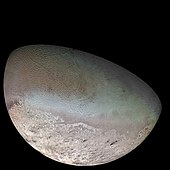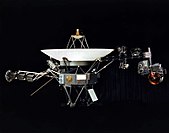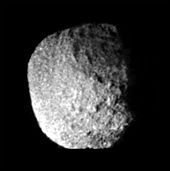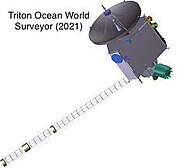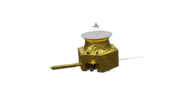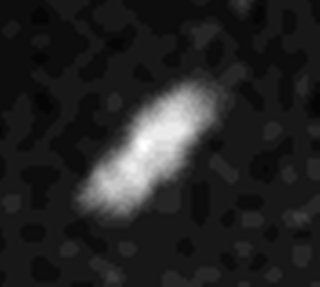
Naiad, named after the naiads of Greek legend, is the innermost satellite of Neptune and the nearest to the center of any gas giant with moons with a distance of 48,224 km from the planet's center. Its orbital period is less than a Neptunian day, resulting in tidal dissipation that will cause its orbit to decay. Eventually it will either crash into Neptune's atmosphere or break up to become a new ring.

Space exploration is the use of astronomy and space technology to explore outer space. While the exploration of space is currently carried out mainly by astronomers with telescopes, its physical exploration is conducted both by uncrewed robotic space probes and human spaceflight. Space exploration, like its classical form astronomy, is one of the main sources for space science.

Voyager 2 is a space probe launched by NASA on August 20, 1977, to study the outer planets and interstellar space beyond the Sun's heliosphere. As a part of the Voyager program, it was launched 16 days before its twin, Voyager 1, on a trajectory that took longer to reach gas giants Jupiter and Saturn but enabled further encounters with ice giants Uranus and Neptune. Voyager 2 remains the only spacecraft to have visited either of the ice giant planets, and was the third of five spacecraft to achieve Solar escape velocity, which will allow it to leave the Solar System.

Triton is the largest natural satellite of the planet Neptune. It is the only moon of Neptune massive enough to be rounded under its own gravity, and orbits Neptune with a retrograde orbit—an orbit in the direction opposite to its planet's rotation—the only large moon in the Solar System to do so. Because of its retrograde orbit and composition similar to Pluto, Triton is thought to have been a dwarf planet, captured from the Kuiper belt. Triton hosts a thin but well-structured atmosphere, composed primarily of nitrogen and hosting a layer of clouds.

The planet Neptune has 16 known moons, which are named for minor water deities and a water creature in Greek mythology. By far the largest of them is Triton, discovered by William Lassell on October 10, 1846, 17 days after the discovery of Neptune itself. Over a century passed before the discovery of the second natural satellite, Nereid, in 1949, and another 40 years passed before Proteus, Neptune's second-largest moon, was discovered in 1989.

The exploration of Uranus has, to date, been through telescopes and a lone probe by NASA's Voyager 2 spacecraft, which made its closest approach to Uranus on January 24, 1986. Voyager 2 discovered 10 moons, studied the planet's cold atmosphere, and examined its ring system, discovering two new rings. It also imaged Uranus' five large moons, revealing that their surfaces are covered with impact craters and canyons.
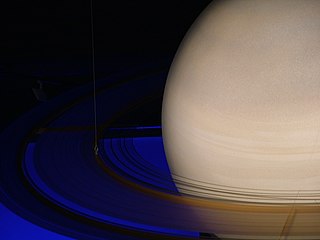
The exploration of Saturn has been solely performed by crewless probes. Three missions were flybys, which formed an extended foundation of knowledge about the system. The Cassini–Huygens spacecraft, launched in 1997, was in orbit from 2004 to 2017.
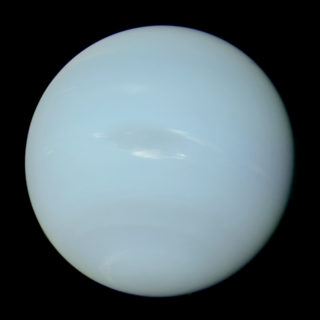
Neptune is the eighth and farthest known planet from the Sun. It is the fourth-largest planet in the Solar System by diameter, the third-most-massive planet, and the densest giant planet. It is 17 times the mass of Earth, and slightly more massive than fellow ice giant Uranus. Neptune is denser and physically smaller than Uranus because its greater mass causes more gravitational compression of its atmosphere. Being composed primarily of gases and liquids, it has no well-defined solid surface. The planet orbits the Sun once every 164.8 years at an orbital distance of 30.1 astronomical units. It is named after the Roman god of the sea and has the astronomical symbol , representing Neptune's trident.

Discovery and exploration of the Solar System is observation, visitation, and increase in knowledge and understanding of Earth's "cosmic neighborhood". This includes the Sun, Earth and the Moon, the major planets Mercury, Venus, Mars, Jupiter, Saturn, Uranus, and Neptune, their satellites, as well as smaller bodies including comets, asteroids, and dust.

The exploration of Pluto began with the arrival of the New Horizons probe in July 2015, though proposals for such a mission had been studied for many decades. There are no plans as yet for a follow-up mission, though follow-up concepts have been studied.

The Planetary Science Decadal Survey is a serial publication of the United States National Research Council produced for NASA and other United States Government Agencies such as the National Science Foundation. The documents identify key questions facing planetary science and outlines recommendations for space and ground-based exploration ten years into the future. Missions to gather data to answer these big questions are described and prioritized, where appropriate. Similar decadal surveys cover astronomy and astrophysics, earth science, and heliophysics.

The Uranus Orbiter and Probe is an orbiter mission concept to study Uranus and its moons. The orbiter would also deploy an atmospheric probe to characterize Uranus's atmosphere. The concept is being developed as a potential large strategic science mission for NASA. The science phase would last 4.5 years and include multiple flybys of each of the major moons.

The following outline is provided as an overview of and topical guide to the Solar System:

Argo was a 2009 spacecraft mission concept by NASA to the outer planets and beyond. The concept included flybys of Jupiter, Saturn, Neptune, and a Kuiper belt object. A focus on Neptune and its largest moon Triton would have helped answer some of the questions generated by Voyager 2's flyby in 1989, and would have provided clues to ice giant formation and evolution.

New Horizons 2 was a proposed mission to the trans-Neptunian objects by NASA. It was conceived as a planetary flyby mission in 2002, based on the New Horizons spacecraft, which was in development at the time. In March 2005, the proposal was not selected for further development because of a shortage of plutonium-238 needed for the radioisotope thermoelectric generator (RTG). The New Horizons 2 study was funded out of the New Frontiers program, and was delivered to the U.S. Congress in June 2005.

Trident is a space mission concept to the outer planets proposed in 2019 to NASA's Discovery Program. The concept includes flybys of Jupiter and Neptune with a focus on Neptune's largest moon Triton.

Neptune Odyssey is an orbiter mission concept to study Neptune and its moons, particularly Triton. The orbiter would enter into a retrograde orbit of Neptune to facilitate simultaneous study of Triton and would launch an atmospheric probe to characterize Neptune's atmosphere. The concept is being developed as a potential large strategic science mission for NASA by a team led by the Applied Physics Laboratory at Johns Hopkins University. The current proposal targets a launch in 2033 using the Space Launch System with arrival at Neptune in 2049, although trajectories using gravity assists at Jupiter have also been considered with launch dates in 2031.
Shensuo, formerly Interstellar Express is a proposed Chinese National Space Administration program designed to explore the heliosphere and interstellar space. The program will feature two or three space probes that will purportedly be launched in 2024 and follow differing trajectories to encounter Jupiter to assist them out of the Solar System. The first probe, IHP-1, will travel toward the nose of the heliosphere, while the second probe, IHP-2, will fly near to the tail, skimming by Neptune and Triton in January 2038. There may be another probe—tentatively IHP-3—which would launch in 2030 to explore to the northern half of the heliosphere. IHP-1 and IHP-2 would be the sixth and seventh spacecraft to leave the Solar System, as well as first non-NASA probes to achieve this status.

Timeline for the New Horizons interplanetary space probe lists the significant events of the launch, transition phases as well as subsequent significant operational mission events; by date and brief description.

